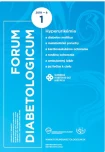Treatment of hyperuricemia
Authors:
Andrej Dukát 1; Peter Sabaka 2; Milan Kriška 3; Peter Gavorník 1; Juraj Payer 1
Authors‘ workplace:
V. interná klinika LF UK a UNB, Nemocnica Ružinov, Bratislava
1; Klinika infektológie a geografickej medicíny LF UK a UNB, Nemocnica akademika Ladislava Dérera, Bratislava
2; Ústav farmakológie a lekárskej farmakológie LF UK v Bratislave
3
Published in:
Forum Diab 2019; 8(1): 37-39
Category:
Review Article
Overview
During last decades potential relationship of increased acid uric to many clinical states in internal medicine was described. However nowadays there are eviden-ces, that hyperuricaemia represents an useful biomarker, also from the preven-tive point of view. Therefore targeted therapy and complex management of risk patient with hyperuricaemia and gout is of importance.
Keywords:
hyperuricemia – acid uric
Sources
- Gertler MM, Garn SM, Levine SA. Serum uric acid in relation to age and phy-sique in health and coronary heart disease. Ann Intern Med 1951; 34(6): 1421–1431.
- Gavorník P, Dukát, A, Gašpar Ľ et al. Klinický význam a liečba hyperurikémie. Slov Klin Prax 2007; 1(1):18–20.
- Dukát A, Sabaka P, Gajdošík J et al. Epidemiologické údaje o výskyte hyperurikémie u mužov a u žien v podmienkach primárnej liečebnej starostlivosti na Slovensku. Vnitř Lék 2015; 61(Suppl 5): S7-S11.
- Borghi C, Perez-Ruiz F. Urate lowering therapies in the treatment of gout: a systematic review and meta-analysis. Eur Rev Med Pharmacol Sci 2016; 20(5): 983–992.
- Richette P, Flipo RN, Patrikos DK. Characteristics and management of gout patients in Europe: data from a large cohort of patients. Eur Rev Med Pharmacol Sci 2015 : 19(4): 630–639.
- Khanna D, Fitzgerald JD, Khanna PP et al. 2012 American College of Rheumatology guidelines for management of gout. Part 1: Systematic nonpharmacologic and pharmacologic therapeutic approaches to hyperuricemia. Arthritis Care Res (Hoboken) 2012; 64(10): 1431–1446. Dostupné z DOI: <http://dx.doi.org/10.1002/acr.21772>.
- Khanna D, Khanna PP, Fitzgerald JD et al. American College of Rheumatology guidelines for management of gout. Part 2: Therapy and antiinflammatory prophylaxis of acute gouty arthritis. Arthritis Care Res (Hoboken) 2012; 64(10): 1447–1461. Dostupné z DOI: <http://dx.doi.org/10.1002/acr.21773>.
- Zhang W, Doherty M, Pascual E et al. EULAR evidence based Standing Committee for International Clinical Studies Including Therapeutics (ESCISIT). Ann Rheum Dis 2006; 65(10): 1301–1311. Dostupné z DOI: <http://dx.doi.org/10.1136/ard.2006.055251>.
- Fang J, Alderman MH. Serum uric acid and cardiovascular mortality. The NHANES I epidemiologic follow-up study, 1971–1992. JAMA. 2000; 283(18): 2404–2410. Dostupné z DOI: <http://dx.doi.org/10.1001/jama.283.18.2404>.
- Huang H, Huang B, Li Y et l. Uric acid and risk of heart failure: a systematic review and meta-analysis. Eur J Heart Fail 2014; 16(1): 15–24. Dostupné z DOI: <http://dx.doi.org/10.1093/eurjhf/hft132.>.
Labels
Diabetology Endocrinology Internal medicineArticle was published in
Forum Diabetologicum

2019 Issue 1
Most read in this issue
- Gout as a new old problem faced by an outpatient care physician
- Treatment of hyperuricemia
- Hyperuricemia and cardiovascular diseases
- Uric acid: pathophysiological implications
